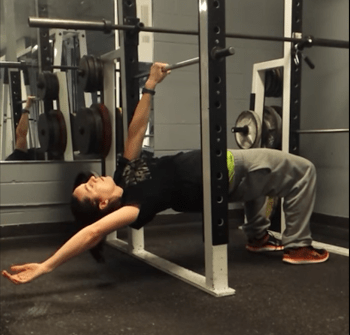
Gravity
Ah, gravity. The beautiful constant. 9.8 meters per second (squared) you can rely on again and again to hold you down. Many times we see it as our enemy, a hindrance to our speed and power. But in the world of mobility, gravity is a marvelous tool, given freely to everyone and accessible at any time.
Since gravity tethers you to the ground, the first step to using it in your advantage is to somehow elevate yourself off of it. Separating from a constant allows for adaptation. You can hang, step up on a box, lay on a bench, or even jump to get a more dynamic effect. Changing the orientation of your body also provides the brain and muscle sensors to be exposed to a novel stimulus.
We sit and act upright almost 100% of our active moving time, so your body has plenty of practice orientating itself vertically. If there’s a motor control problem or dysfunction, lying horizontal is an effective way of resetting. Locomotion and coordination was first learned on our backs as babies, and it’s often returned to when attempting to reprogram movement patterns after injury or chronic pain. Gravity assisted movement can help assess whether restriction is a structural problem or neurological problem. Achieving arms overhead on the ground should be a repeatable task when standing. It’s the how that gets scrambled.
The modern tendency to exist hunched over with forward head posture, for example, creates a new normal where we like to live in flexion. Instead of ‘forcing’ unfamiliar extension over a roller or medicine ball, you can simply slide yourself off the edge of a bench, pausing at each segment that feels it requires a longer duration of opening:
Slower tends to translate into less threat of stiffening.
The same principle can be applied to rotation. Driving the knee across is replaced by letting the hip fall. Your only intention is controlling the brakes.
Everything connected to a surface reflexively presses into it. As the leg drops, the upper trunk and torso have to build greater tension to stabilize the greater load. More weight relaxed is accomplished by more grounded musculature contracting.
Shoulder flexion can be tested by positioning yourself in a horizontal hang and gently letting one arm fall back. Again, there is no intent to drive the arm to start the descent. The simple motive is to consistently control the speed in which gravity leads it – more brake at the top, and less brake at the bottom:
The gripping hand, hips, and obliques tighten to encourage the moving arm to let go. Tension points inhibiting movement must be transferred elsewhere. Controlled motion stems from a stable base.
How much contact the body has with the fixed surface plays into the equation as well. A hand takes up much less surface area than the shoulders. The less connected, the more stabilization is required, and the more stiffness must be generated by both the grounded and neighboring joints. Furthermore, the direction of release is directly related to the vector of hold. Let’s use a leg example to examine this further:
I begin looking for the hip to just drop, so the tabletop leg is situated parallel. Once I attempt rotation, though, I flex the knee and hook the foot, creating a steady fulcrum/axis in which to teeter/revolve around. I also tense the free-floating leg to further build a steady confidence to sink into.
One last example of gravity play is perceiving it as a modified accomplice to PAILs/RAILs. A kettlebell is only loaded on one end. The way in which you hold it will always draw the most force on the bulbous side. If you can create a singular motion that sequentially stresses both sides of tissue, you can practice reactive isometric loads:
In the beginning of the movement, the kettlebell stresses the under-forearm (or wrist flexors). By the time the elbow is lengthened into a full reverse curl, however, the strain is put on the top-forearm (or extensors.) Imagine drawing a line straight down from the bell ball. This is gravity. Where would the work have to come from to keep the bell steady throughout? The switch begins just after the hand crosses the waist or 90-degree mark.
TO REVIEW:
- Gravity allows muscles to relax into a surface or its pull.
- Create space between the body and ground to manipulate the constant.
- Gravity can help assess whether joint restriction is structural or neurological.
- “Control the brakes” and “lay off the gas.”
- Gravity can assist motion in any plane of motion.
- Orientating the body horizontally creates an opportunity for reset.
- Integrating the principals of gravity with systematic protocols (like FRC) gives you a much larger movement menu to experiment with.



